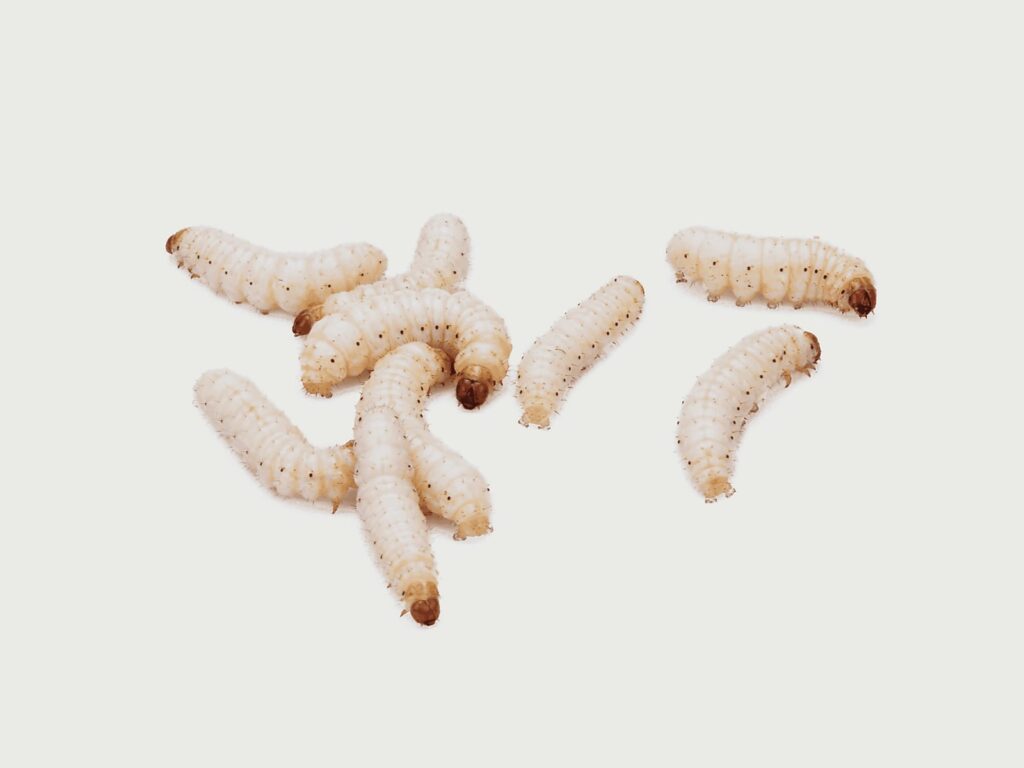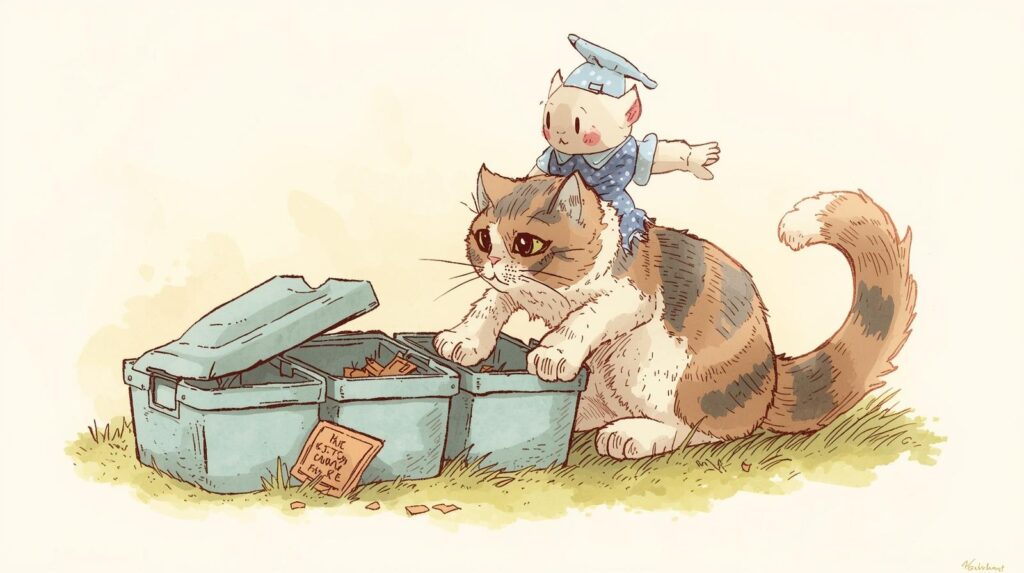Cats vs. Maggots is certain seasonal conditions, especially during the warmer months of the year, can bring unexpected challenges for felines. One such issue is myiasis, an infestation caused by maggots, the white, tubular larvae of flies like bottle, blow, and house flies. These winged insects are particularly attracted to felines with fecal-soaked fur, long coats, or open wounds. Newborn kittens, fighting toms, and those suffering from urinary or fecal incontinence are at high risk. The flies lay eggs in areas with necrotic tissue, matted feces, or moist, inflamed skin, which hatch into maggots within three days, feeding on the feline’s flesh and worsening the condition.

Cats vs. Maggots-The Answer
Cats are prone to myiasis, a maggot infestation, during warmer months, especially if they have fecal-soaked fur, long coats, open wounds, or conditions like incontinence. Flies lay eggs on necrotic tissue or moist skin, hatching into larvae that feed on the cat’s flesh. Hidden beneath fur, maggots worsen the condition by burrowing into wounds. Red sores, infections, and matted fur signal urgent veterinary care involving sedation, maggot removal, and cleaning. Preventative measures include grooming, waste management, and blocking flies.
This issue often remains unnoticed for a long period, as the small larvae hide beneath the cat’s hair and burrow into swollen abscesses or draining wounds, releasing enzymes from their saliva to penetrate deeper. Signs like red, raised sores, bacterial infections, or thin, matted fur signal the need for urgent care. Veterinarians diagnose and treat maggot infestations by carefully sedating or anesthetizing the cat, removing the larvae, and cleaning the area thoroughly. Preventative measures like proper grooming, keeping organic garbage away, and using screens to block flies can help reduce the risk of infestation during these critical months.
Table of Contents
Common Symptoms of Maggots in Cats
- Physical Symptoms:
- Presence of white, tubular worms (maggots) in or around wounds.
- Reddening, swelling, and raised sores on the skin caused by enzyme-rich saliva.
- Moist wounds that are oozing or emit a pungent odour.
- Behavioral Signs:
- Increased vocalizing due to discomfort or pain.
- Restlessness and difficulty sleeping, indicating irritation.
- Visible Wound Changes:
- Red, blistered skin or sticky, inflamed areas around wounds.
- Evidence of pyoderma or other infections from maggot infestation.
- Diagnostic Clues:
- Shaving hair near affected areas reveals tracks or signs of maggots.
- Look for uninvited guests in wounds caused by poor hygiene or unclean environments.
- Risk Factors:
- Infested wounds increase the risk of bacterial infection and further complications if untreated.

Why Do Maggots Appear in Cat Litter?
Maggots in your cat litter can be a nasty surprise, often caused by an unclean litter box becoming a breeding ground for flies. These persistent fly moms seek the perfect warm, cozy spot to lay their eggs, and leftover food and waste in the litter box create a buffet for their babies. Neglecting regular scooping and cleaning gives flies the green light to settle in, drawn by the smell of an unkempt bathroom. Daily cleaning not only keeps these buzzing critters at bay but also ensures a fresh, hygienic space for your furry friend.
Act Quickly and Carefully: Addressing maggots in cats is urgent as these tubular worms, caused by myiasis, can infest open skin sores or infected areas, leading to severe wounds.
Treatment of Maggots in Cats
Inspect Your Cat:
- Check the fur for signs of infestation like movement near the affected area or foul odors.
- Shave the surrounding hair coat for better visibility of the wound if needed.
- Always wear gloves to prevent infection.
Initial Treatment:
- Use sterile tweezers to remove visible maggots from the exposed wound.
- Clean the area with an antiseptic and apply topical therapy to reduce the risk of further infection.
Veterinary Intervention:
- For severe infestations, your veterinarian may recommend anti-parasite drugs like Ivermectin or Selamectin (Revolution).
- If secondary conditions arise, such as bladder infection or urinary incontinence, antibiotics and a customized treatment regimen may be needed.
Preventive Measures:
- Use medications like Imidacloprid (Advantage Multi or Advocate) or moxidectin to prevent future infestations.
Home Care and Prevention
- Recovery may involve skin grafts, specialized wound care, and pain medications for extreme cases.
- Maggot infestations are a creepy reality that can harm your furry buddy if precautions are overlooked.
- Cats with unkempt hair coats or hidden wounds are prone to attracting blowflies that lay eggs, leading to myiasis.
- Weak or debilitated cats should have their skin and wounds checked frequently to prevent complications from urine staining or fecal matter.
- Keep litter boxes pristine and maggot-free by frequently checking for issues.
- Used litter should be tossed into a trash bag, tightly knot-sealed, and placed in a covered trash can to eliminate smell attractors.
- Maintain a tidy fortress of cleanliness as the best defense system against infestations.
- Create a no-fly zone by using electric zappers, natural deterrents like basil or lavender, and screens on windows and doors to block flies.
- Check indoors daily for urine and feces, and ensure these are washed promptly to prevent diseases and infections.
- If an infestation occurs, visit a veterinarian to have the maggots removed and the affected area treated.
- Properly cover pet waste to reduce the chances of flies penetrating your home, ensuring your furry buddy stays safe and healthy.
Cleaning Cat Litter Box Techniques
Keeping your cat’s bathroom clean is essential for their health and comfort. Start by scooping daily to remove clumps and fight odors, which helps maintain a sparkling zone for your furry friend. Replacing old litter with fresh new options weekly can prevent pesky flies and unwanted guests like maggots. It’s also a key step in ensuring the hygiene of your cat’s throne, making it a true sanctuary for feline royalty.
Best Practices for Hygiene in Cat Litter
For a deeper clean, give the box a spa wash using soap and water to eliminate smells and maintain a maggot-free fortress. For ease of maintenance, you can utilize specialized tools and modern gadgets like self-cleaning boxes, mats for tracking, and even flushable or compostable litters. These pro tips and tricks can transform cleaning into a hassle-free routine. Think of it as part of your cat’s spa day, paired with other care like brushing teeth or grooming. Whether you’re replacing the litter or dealing with mess, these tools are a jackpot for ensuring a safe and healthy environment for your cat while making your life easier.
Conclusion
Maggot infestations in cats, caused by flies attracted to wounds or unclean fur, can lead to severe health issues if untreated. Early detection, proper wound cleaning, and veterinary care are essential for effective treatment. Preventive measures like regular grooming, maintaining a clean litter box, and using fly deterrents can significantly reduce the risk. Prioritizing hygiene and proactive care ensures a safe, healthy environment for your feline friend.
FAQ’s
Is it common for cats to get maggots?
Older cats or those with matted hair are prone to maggots when flies lay eggs on wounds or dirty areas. The larvae invade tissue, worsening infections. Regular grooming and checking for hidden wounds are crucial, especially in warm weather.
Why do my fur babies end up with maggots?
Maggots can harm your cats, especially in warmer months when flies are attracted to untreated wounds or dirty litter boxes. Regularly checking for hidden wounds, keeping the litter box clean, and treating any cuts promptly can prevent infestations and protect your pet’s health.
Are maggots bad news for kitties?
Cats’ curiosity can expose them to maggots, which thrive in dirty, damp spaces and can infest wounds, causing infections. If ingested, maggots may harm their digestive system. Keep their environment clean, inspect for injuries, and groom regularly to avoid these risks.
Does cat litter attract maggots?
Neglected litter boxes can attract flies, creating a breeding ground for maggots due to the moisture and odor. Regular cleaning and waste removal prevent flies from laying eggs, keeping the area free from infestations.


